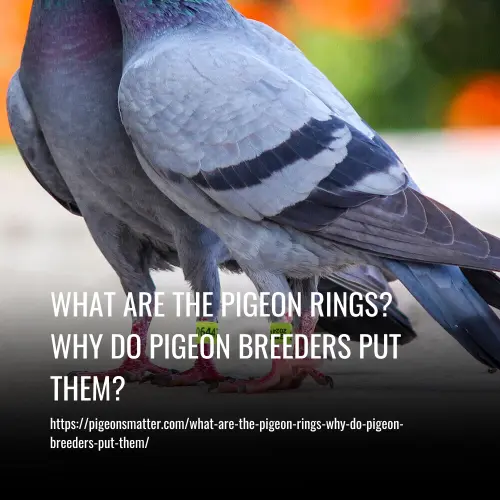What are the Pigeon Rings? Why Do Pigeon Breeders Put Them?
This post contains affiliate links. As an Amazon Associate, we earn from qualifying purchases.
Pigeon rings are small bands that are placed on pigeons’ feet by breeders. While there isn’t a specific reason for using pigeon rings, research has shown that there are multiple reasons for their use. Some breeders use them for identification and tracking purposes, while others use them for breeding control or to participate in pigeon racing events.
It’s not mandatory for new pigeon owners to use these rings, and after learning about their purposes, it may not be necessary for all pigeon enthusiasts. Therefore, the decision to use pigeon rings depends on the specific needs and goals of the breeder or owner.

Why Pigeon Breeders Put Pigeon Rings To Their Pigeons
There are three main reasons why pigeon breeders put pigeon rings on their pigeons: beautification, identification, and contact information.
1. Beautification
Pigeon breeders use pigeon rings to enhance the appearance of their pigeons. These rings, which are often affordable and obtained in bulk, add an attractive element to the pigeons’ appearance. Some breeders even customize the rings by having their phone numbers printed on them, further adding to their aesthetic appeal.
2. Identification
Pigeon rings are crucial for identifying individual pigeons. Breeders may use specific types of rings or multiple rings to distinguish between different pigeons. This is particularly important when separating high-flying pigeons from the rest of the flock or when keeping newly acquired pigeons or specific breeds separate from others.
3. Contact Information
Pigeon breeders and experts often place their contact numbers on the pigeon rings. This serves as a precautionary measure in case their pigeons go missing. Pigeons can easily become disoriented or lost, especially in unfavorable weather conditions such as heavy rain or thunderstorms. If someone finds a pigeon with a ring, they can use the contact number to reach out to the owner and facilitate the pigeon’s safe return.
How To Ring A Pigeon
To ring a baby pigeon, you will need a ring for the bird, dishwashing liquid, and a small tool to help slide the ring onto the bird’s foot. You can use a kebab stick or similar tool to gently pull the bird’s toe out, making it easier to slide the ring onto the foot.
Gently apply a dab of dishwashing liquid to the foot to help the ring slide on easily. Then, hold the bird up and carefully slide the ring onto the left or right leg, as per your preference. Be sure to slide the ring down until it reaches the knuckle, and then work the toe under the ring gently to pull it through.
Once the toe is through the ring, carefully pull it back down, and your bird will be properly ringed. This process ensures the ring is secure and will not come off easily.
By following these simple steps, you can effectively and safely ring a baby pigeon, using the necessary tools and precautions to ensure the ring is in place securely.
How to read a Pigeon’s Ring
To find the owner of a lost pigeon, it’s important to know how to read the pigeon’s ring for identification. The ring letters will typically indicate the club or country where the pigeon is from, while the year represents the year the pigeon was hatched. The individual number on the ring is unique to each pigeon.
Moreover, some rings include a phone number or website for easy contact. If the ring has a phone number, simply dial it to find the owner. If not, a quick web search using the information on the ring can help locate the club or organization, which can then put you in touch with the pigeon’s owner.
By understanding the information on the ring, you can ensure the lost pigeon is safely returned to its owner.
FAQs
Pigeon rings are usually placed on the bird’s leg when they are just a few days old. The process is quick and does not cause harm to the bird. Breeders use specialized tools to carefully place the ring on the bird’s leg.
While pigeon rings are not mandatory for all pet pigeons, they are commonly used in breeding and racing circles to maintain accurate records and track bloodlines.
When properly fitted, pigeon rings do not cause any discomfort to the birds. They are designed to be lightweight and do not interfere with the pigeon’s movement.
Pigeon rings are meant to stay on the bird’s leg for the duration of its life and cannot be removed without causing harm to the bird.
Conclusion
In conclusion, pigeon rings are small, uniquely numbered bands that are placed on a pigeon’s leg for identification purposes. Pigeon breeders put these rings on their pigeons mainly to keep track of their birds, monitor their health, and ensure that they are not lost or stolen. The rings also help breeders to record and track the lineage and breeding history of their pigeons.
Additionally, pigeon rings play a crucial role in pigeon racing, as they provide a way to identify and authenticate the pigeons during races. Overall, pigeon rings are essential tools for pigeon breeders and enthusiasts, helping them to manage and care for their birds effectively.